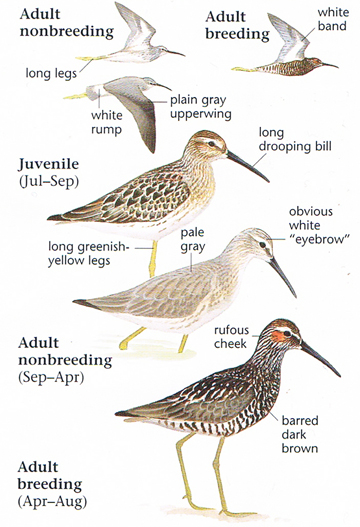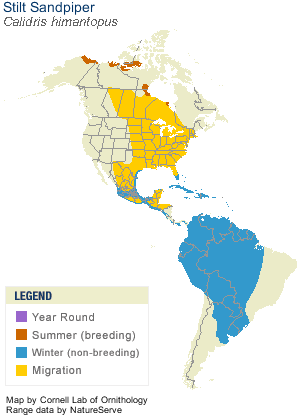|
Cool Facts |
 Photo
taken from:
The
Sibley Field Guide to Birds of Western North America by
David Allen Sibley
Photo
taken from:
The
Sibley Field Guide to Birds of Western North America by
David Allen Sibley
|
- The main southward migration route route of the Stilt Sandpiper
passes through the middle of the continent, west of the Mississippi
River. From here, in fall the species migrates over water to the
Caribbean or northern South America, where many birds interrupt their
migration to molt flight feathers before continuing to winter haunts in
inland central South America.
- Stilt Sandpipers nest as close as 12 feet to other shorebirds, but
at least 900 feet from their own kind, probably as a defense against
predators.
- Seeds picked from the water or dry ground can make up nearly
one-third of the diet, depending upon their availability.
- A group of sandpipers has many collective nouns, including a "bind",
"contradiction", "fling", "hill", and "time-step" of sandpipers.
|
|
Description |
Adult Description
Medium-sized sandpiper. Long, greenish legs. Long neck. Long bill,
drooped at the tip. White rump. Gray tail. Wings plain, without white
stripe. Breeding plumage heavily barred on the underside, with dark
blotches on the back, and chestnut cheek patch. Nonbreeding plumage all
gray on back with lighter belly. |
Immature Description
Juvenile similar to nonbreeding adult, but browner, with scaly back with
light edges to feathers, and thin streaks on chest. |
|
Range Map |
|
Taxonomic Hierarchy |

© 2003 Cornell Lab of Ornithology
|
|
Kingdom: |
Animalia |
|
Phylum: |
Chordata |
|
Subphylum: |
Vertebrata |
|
Class: |
Aves |
|
Order: |
Ciconiiformes |
|
Family: |
Scolopacidae |
|
Genus: |
Calidris |
|
Species: |
Calidris himantopus |
|
|
Sound |
|
Call a soft "jeew."
|
|
Identification and
Information
See
Anatomy
of a Bird
|
|
Body |
- Length
Range: 19-22 cm (7.5-8.5 in)
- Weight:
60 g (2.1 oz)
- Size:
Small (5 - 9 in)
- Color
Primary: Brown, Buff
- Underparts:
White with gray-brown barring.
- Upperparts:
Gray-brown with some black and buff
mottling.
- Back
Pattern: Scaled or Scalloped
- Belly
Pattern: Barred or banded
- Breast
Pattern: Barred or banded
|
|
|
|
Head |
- Bill Shape:
Dagger
- Eye Color:
Dark brown.
- Head
Pattern: Eyeline, Capped, Streaked
- Crown Color:
Gray-brown
- Forehead
Color: Gray-brown
- Nape Color:
White with gray-brown streaking.
- Throat
Color: White with gray-brown streaking.
- Cere color:
No Data
|
|
|
Flight |
- Flight
Pattern: Strong direct flight with
powerful rapid wing beats.
- Wingspan
Range: 38-43 cm (15-17 in)
- Wing Shape:
Tapered-Wings
- Tail Shape:
Pointed Tail
- Tail
Pattern: Barred
- Upper Tail:
White with gray-brown barring.
- Under Tail:
White with gray-brown barring.
- Leg Color:
Yellow-green
|
|
|
Breeding |
-
Breeding Location:
Tundra, Meadows, sedge, well-drained
-
Breeding Type:
Monogamous
-
Breeding Population:
- Egg
Color:
Cream, pale green or olive green with brown
spots
- Number
of Eggs:
4
-
Incubation Days: 19 - 21
- Egg
Incubator:
Both sexes
- Nest
Material:
Grasses.
-
Migration: Migratory
- Condition at Hatching: Active and
covered with down.
|
|
|
Other
Names |
Similar
Species |
- Becasseau à èchasses (French)
- Playero pato largo (Spanish)
|
- Nonbreeding Wilson's Phalarope has entirely white underside,
thinner, straight bill, and more active behavior.
- Lesser Yellowlegs has mostly white tail, bright yellow legs.
- Dowitchers have shorter legs, longer, straight bills, and a white
triangle extending up the back.
- Curlew Sandpiper has white wing stripe, more slender and more
curved bill, and a darker tail.
|
|
Conservation Status |
|
Numbers may be declining. Degradation of breeding
environment may be caused by over population of Snow Geese
on the tundra. |
|
Habitat |
Sources
used to Construct this Page: |
|
Breeds in sedge tundra near water, often near wooded borders of the
taiga. On migration and in winter found along mudflats, flooded
fields, shallow ponds and pools, and marshes. |
- Klima, J., and J. R. Jehl, Jr. 1998. Stilt Sandpiper
(Calidris himantopus). In The Birds of North
America, No. 341 (A. Poole and F. Gill, eds.). The Birds
of North America, Inc., Philadelphia, PA.
|
|
Food |
|
Stilt Sandpipers feeds on insects, small snails, and small seeds; |
|
Behavior |
|
Stilt Sandpipers forage by probing in soft mud on mudflats or while
wading in shallow water. |
|
|
|
|

